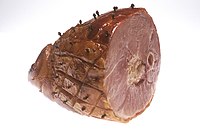
Photo from wikipedia
In the present study, we repeatedly used the surface-applied paste electrolyte cell to record the EIS spectra of four coating systems with different barrier properties exposed to different environments. The… Click to show full abstract
In the present study, we repeatedly used the surface-applied paste electrolyte cell to record the EIS spectra of four coating systems with different barrier properties exposed to different environments. The absence of a liquid electrolyte allows direct recording of the electrolyte-unaltered coating response to environmental stressors. Exposures included humidity between 23 and 95%, temperatures between 10 and 50°C, 720 hours of ISO 9227 neutral salt spray, 1 year in mild continental urban climate, and for comparison, 3 years of ISO 16773 3.5% NaCl immersion. The coatings showed significantly different temperature susceptibility of impedance revealing two temperature ranges with activation energies corresponding to ionic conductivity below 20°C and conductivity influenced by polymer chain movements above 30°C. Impedances measured for intact coatings or impedances calculated from the assumed range of dielectric constant and coating thicknesses can be used as references. The EIS outcome of the laboratory tests and the time- and temperature-resolved EIS responses under atmospheric exposure were compared with the reference impedances of the coatings. Mild continental climate exposure at temperatures < 35°C and immersion at 23±2°C yielded better barrier performance for the two solvent based coating systems compared to the two waterborne systems of comparable thickness and number of layers. The NSS test that proceeds at 35°C yielded better performance of the both solvent based coatings over the waterborne coatings, regardless of the thickness. EIS quantification of barrier performance, which excludes the influence of the liquid electrolyte, has provided insight into the temperature effect on barrier behavior of the coatings under non-accelerated and accelerated exposures and the final coating rating.
Journal Title: Corrosion
Year Published: 2023
Link to full text (if available)
Share on Social Media: Sign Up to like & get
recommendations!